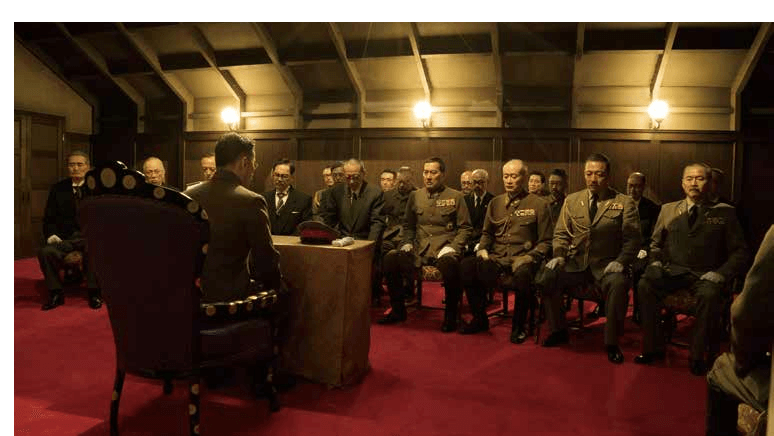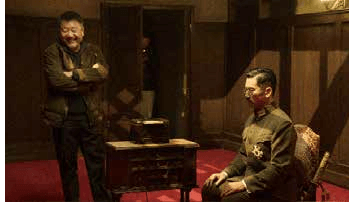Issue:

A star studded film out this month portrays the frantic 24 hours leading up to Emperor Hirohito’s surrender speech. The film’s maker wants it to be a spark that gets people thinking of Japan’s future.
The still thorny issue of Emperor Hirohito’s responsibility for the Pacific War is at the heart of Masato Harada’s The Emperor in August. The film, with the Japanese title Nihon no Ichiban Nagai Hi (Japan’s Longest Day), is set for release on Aug. 8, a week before the 70th anniversary of the end of the war. Based on Kazutoshi Hando’s nonfiction novel Nihon no Ichiban Nagai Hi, the film focuses on the final 24 hours of the war, as a group of army officers who want the country to continue fighting attempt a coup to prevent the broadcast of the emperor’s surrender address to the devastated nation.
The production features such Japanese cinema stars as Koji Yakusho (Babel, Memoirs of a Geisha) as General Anami, Shinichi Tsutsumi (Departures) as Prime Minister Kantaro Suzuki and Masahiro Motoki (Departures) as the young Emperor Hirohito, as they deliberate over accepting the Potsdam Declaration calling for Japan to surrender.
Harada’s experiences watching movies in the postwar period shaped a love of American cinema. “I was born in 1949, just after GHQ opened up the Central Distribution Company to release films. When they started it, they contacted local theaters and 32 of them around the country became Central Theaters. And one of them was in Numazu, where I was born,” says Harada, who is probably best known outside Japan as an actor the villain Omura in The Last Samurai.
The first movie Harada saw was Fred Zinneman’s The Search, at age five, at Numazu’s Central Theater, turning him into a big Montgomery Clift fan. “I also grew up with Japanese jidaigeki [samurai period dramas] and Westerns. I couldn’t read the subtitles and could only understand what was happening if my mother, who used to take me, would explain. That was how I was exposed to American culture.”
Working at the inn his mother owned were several maids who had experienced the war and talked to him about the town being machine gunned by Mustang P51s and bombed by B52s. “The B52s which came to bombard Tokyo or Nagoya, left from Saipan, and the P51 fighters were stationed on Iwo Jima; they would join up over Numazu and head for Mt. Fuji. On their return, if they had any bombs left, they would drop them on Numazu.
“Yet those maids, who had experienced all that, took me to see those war movies and were big fans of Gregory Peck and John Wayne,” recalls Harada, who says he found himself rooting for the Allied forces in the films. “When I saw Sands of Iwo Jima and John Wayne’s character Sgt. Stryker was shot, I screamed. I hated the Japanese soldiers. That’s how I grew up.”
FINDING JAPANESE WAR MOVIES to be overly sentimental and melodramatic, Harada has similar feelings about an earlier version of Japan’s Longest Day, made by director Kihachi Okamoto in 1967. He insists that his is not a remake of that film, which he has a number of misgivings about. “The first time I saw the Kihachi Okamoto version, when I was 18, I was expecting a lot, as I was a big fan of Okamoto and grew up watching war movies,” says Harada.
Okamoto’s Japan’s Longest Day, he says, “had over the top characters throughout the film.” “Even the Mifune portrayal of General Anami was that kind of over the top character; it was the usual Mifune. And Anami wasn’t shown as a husband or father, so I felt there was something wrong. I also had one big question even back at 18: where was Tojo at the end of the war? I always believed he was responsible for everything.”
In Japanese films of the 1960s, the emperor’s face couldn’t be clearly shown, so in the Okamoto version, only long shots or those of the back of his head were used, Harada points out. “I realized everything had changed when Alexander Sakurov’s The Sun (a biographical film of Emperor Hirohito dealing with the end of the war) was shown in Japan in 2006.”
The atmosphere at The Sun’s first screening was extremely tense, recalls Harada, with the audience and distributor expecting demonstrations or worse by nationalists. The portrayal of the emperor by Issey Ogata featured a mumbling style of speech that Hirohito developed later in life, but hadn’t acquired at the end of the war. Harada was unimpressed by what he calls a “caricature” of the emperor and also had mixed feelings (despite “not being a royalist”) about him being shown in such a personal, close up fashion.
He decided at that time to tackle Japan’s Longest Day and began to read all he could on the protagonists of the events in the final days of the war.
“I was ready to take on the film if I could get the green light from one of the major studios, but nothing happened,” he says. “Then, in the autumn of 2013, I was talking future projects with two producer friends when they mentioned that in two years it would be the 70th anniversary of the end of the war. One of them was a Toho producer, and since the original film was produced and distributed by Toho, I asked him about the rights. He checked on the spot and said that Toho wasn’t thinking of redoing it.”
Realizing this was a chance he couldn’t pass up, Harada got an initial greenlight from Shochiku two months later. He began writing the first draft in December 2013 and proposed combining the Japanese title of the original with a new English name, to come up with Nihon no Ichiban Nagai Hi The Emperor in August, partly to differentiate it from the Okamoto version. He worked nights on revisions to the script at his Kyoto hotel, after days spent wrapping up the shooting of his film Kakekomi.
After Toho got word of the project and the cast Harada had assembled, the company realized it had let a big opportunity slip through its fingers. One reason for Toho’s initial reluctance may have been that there weren’t any particularly significant movies made for the 50th and 60th anniversaries, suggests Harada. “Maybe Toho believed that it wasn’t appropriate to make any kind of big war film for the 70th anniversary; nobody knew two years ago that the Abe regime was going to go in this direction.”
ANOTHER FACTOR IN HIS wanting to make the film is what he believes are misunderstandings in two acclaimed American nonfiction books that focused on the life of the emperor. One was John Dower’s Embracing Defeat, the other Herbert Bix’s Hirohito and the Making of Modern Japan, which won the Pulitzer Prize in 2000 and 2001, respectively. Both of these dealt with the question of the emperor’s responsibility for the war.
Bix’s basic position was that the emperor was responsible for the war because he was the only free man in Japan at the time. “That was not true, and it’s why I wanted to make this film: he was not free. When he used the phrases, ‘enduring the unendurable and suffering what is insufferable,’ I believe he was talking about himself.”
The dialogue “Get rid of the military, save the country” is crucial to the film, according to Harada

“We have a particular word in Japanese, sojo suru or joso suru, that means ‘report to the emperor.’ The generals at the time reported what they were doing to the emperor, and then went back and did what they wanted to do. It was what we call ‘shouting at the shrine wall.’ He was supreme commander, but as a constitutional monarch, he could only approve of what they were doing. He was against the invasion of China in the 1930s, but they went ahead with it anyway.”
The 1967 version didn’t portray the ambivalence of the protagonists’ feelings, believes Harada. “In great American and European movies, the characters such as Lawrence of Arabia or Marlon Brando’s boxer in On the Waterfront have that kind of ambivalence. I think one of the reasons Kurosawa’s films were accepted by foreign audiences is that his characters also had that kind of ambivalence.”
The portrayal of Kantaro, Anami and the emperor as a family, with the general as the elder son, the emperor as the younger and the prime minister as the patriarch, was some thing Harada says he wanted to emphasize, particularly in the scene where the young monarch is asked for an imperial decision on ending the war. The dialogue “Gun o nakushite, kuni o nokosu” (get rid of the military, save the country) is crucial to the film, according to Harada.
HARADA BELIEVES THAT THE film is particularly relevant given the 70th anniversary, the reform of the pacifist Constitution and the direction of the current government. He is concerned, however, that the ambivalence he deliberately aimed for may be misinterpreted in some quarters. “The Abe regime is changing Article 9 of the Constitution because they say it was imposed by America; I completely disagree with that position. There will be a screening for politicians at the end of July, and I wonder how they will view this film and if they will try and distort my intention.”
He is also worried that years of glossing over the events of WWII have left a generation unaware of its importance. “When I was in high school, the teachers just skipped over contemporary history, the war and its aftermath,” he recalls. “In the mid 70s, people were worried that the college kids then didn’t even know America and Japan had fought a war.
“Well, those kids are now the mothers, fathers and teachers of today’s generation, and they don’t seem to care about what direction Japan will take. With the Abe administration lowering the age of voting, it’s time for young Japanese to start thinking about how this country was made. I hope this film will become one turning point for them to start thinking about where they came from and where they’re going."
The Emperor in August will be shown at the FCCJ on Aug. 3, at 6:30 pm
Gavin Blair covers Japanese business, society and culture for publications in America, Asia and Europe.

